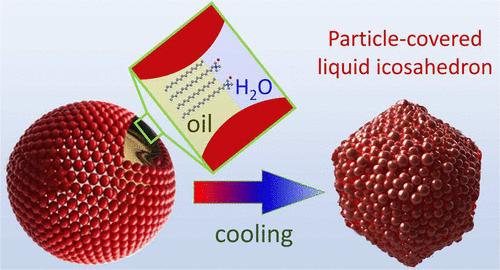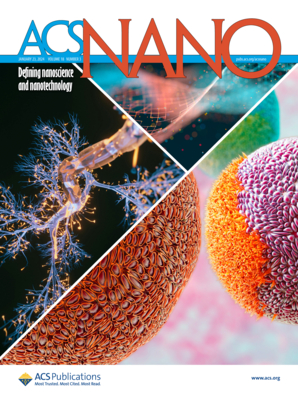Sphere-to-Icosahedron Droplet Shape Transformations in Interfacially Frozen Pickering Emulsions
IF 15.8
1区 材料科学
Q1 CHEMISTRY, MULTIDISCIPLINARY
引用次数: 0
Abstract
Surfactant-stabilized oil-in-water and water-in-oil emulsions, encompassing a wide range of chemical compositions, exhibit remarkable temperature-controlled sphere-to-icosahedron droplet shape transformations. These transformations are controlled by the elasticity and closed-surface topology of a self-assembled interfacial crystalline monolayer. Since many practical emulsions are synergistically costabilized by both surfactants and colloidal particles, we explore the influence of surface-adsorbed hydrophobic and hydrophilic colloidal particles on these shape transformations. We find that these shape transformations persist even at high interfacial colloidal densities, despite the colloids disrupting the molecular interfacial crystal’s topology. We employ computer simulations to elucidate the role of colloidal particles in droplet shape control of these widely employed emulsions. Surprisingly, we observe that the particles serve as incompressible inclusions, which do not disrupt the out-of-plane buckling of the interfacial crystal. Our findings demonstrate temperature-control of droplet shape transformations and self-division in emulsions costabilized by colloidal particles and molecular surfactants. The fundamental mechanisms uncovered here may have broad implications for biological systems, enable unexplored strategies for microcargo delivery and release, and inspire unconventional approaches in smart material design.

求助全文
约1分钟内获得全文
求助全文
来源期刊

ACS Nano
工程技术-材料科学:综合
CiteScore
26.00
自引率
4.10%
发文量
1627
审稿时长
1.7 months
期刊介绍:
ACS Nano, published monthly, serves as an international forum for comprehensive articles on nanoscience and nanotechnology research at the intersections of chemistry, biology, materials science, physics, and engineering. The journal fosters communication among scientists in these communities, facilitating collaboration, new research opportunities, and advancements through discoveries. ACS Nano covers synthesis, assembly, characterization, theory, and simulation of nanostructures, nanobiotechnology, nanofabrication, methods and tools for nanoscience and nanotechnology, and self- and directed-assembly. Alongside original research articles, it offers thorough reviews, perspectives on cutting-edge research, and discussions envisioning the future of nanoscience and nanotechnology.
 求助内容:
求助内容: 应助结果提醒方式:
应助结果提醒方式:


